NCERT Exemplar Solutions for Class 11 Biology Chapter 4 Animal Kingdom
These Solutions are part of NCERT Exemplar Solutions for Class 11 Biology. Here we have given NCERT Exemplar Solutions for Class 11 Biology Chapter 4 Animal Kingdom.
VERY SHORT ANSWER QUESTIONS
Question 1.
What is the importance of pneumatic bones and air sacs in Aves?
Solution:
Birds possess light wfi’ght bones that contain internal spaces filled with air, which are pneumatic bones. They are an adaptation for flight as they help in, reducing the body weight. Aerodynamic lungs with specialized air sacs are an additional feature that aids birds in flying (e.g., bald eagle, pigeon).
Question 2.
What is metagenesis? Mention an example which exhibits this phenomenon.
Solution:
The phenomenon in which one generation of certain plants and animals reproduce asexually, followed by the sexually reproducing generation is metagenesis. Both the forms in metagenesis are diploid hence, it is known as the false alternation of generation. Coelenterates exhibit metagenesis (e.g., Obelia) where in its life cycle polyp form alternates with medusa.
Question 3.
What is the role of feathers?
Solution:
Feathers are the epidermal out growths that form distinctive outer covering or plumage in birds.
A variety of role are played by feathers which includes:
(i) They provide life and help in flight, by creating airfoil shape for wings.
(ii) They help in maintaining body temperature.
(iii) Feathers play a vital role in mating by providing secondary sexual that characters in both the sexes the colour and markings determine the alteractiveness of mate.
Question 4.
Which group of chordates posses sucking and circular mouth without jaws?
Solution:
Class-Cyclostomata is comprised of living jawless fishes. They have a circular mouth and lack jaws, hence they are also called agnathans. The mouth works like a sucker and is surrounded by tentacles (e.g., lampreys and haglish). These also prosses rectroctable teeth that are homy.
Question 5.
Mention two modifications in reptiles required for terrestrial mode of life.
Solution:
Certain characters acquired by reptiles for the terrestrial adaptations include.
(i) Body is covered with dry and comified skin and epidermal scales or scutes.
(ii) Internal fertilisation.
Question 6.
What is the role of radula in molluscs?
Solution:
The radula is a special rasping structure present many molluscs. It is used to scrape and scratch the food and to create depressions in rocks used as habitat.
It bears many rows of tiny teeth that are replaced
as they wear down e.g., Limplet is a marine invertebrate that uses its radula for creating home by boring a shallow hole in the rock.
Question 7.
Name the animal, which exhibits the
phenomenon of bioluminescence. Mention the
phylum to which it belongs.
Solution:
Bioluminescence is the phenomenon of production and emission of light by an organism as a result of chemical reaction during which chemical energy is converted to light energy. The phenomenon of bioluminescence is exhibited by Ctenoplana from phylum- Ctenophora.
Question 8.
Write one example for each of the following in the space providing.
(a) Cold blooded animal
(b) Warm blooded animal
(c) Animal possessing dry and comified skin
(d) Dioecious animal
Solution:
(a) A cold blooded animal is Crocodilus (crocodile)
(b) Elephas maximus (elephant), (mammal) is a warm blooded animal.
(c) Testudo (tortoise) bears dry and comified skin.
(d) Ascaris (roundworm) is a dioecious animal.
Question 9.
Differentiate between a diplobastic and triploblastic animal.
Solution:
Diploblastic animals are animals in which the cells are arranged in two embryonic layers, an external ectoderm and an internal endoderm (e.g., coelentrates). Animals in which the developing embryo has a third germinal layer, i. e., mesoderm lying between the ectoderm and endoderm are calledtriploblastic animals, (e.g., chordates).
Question 10.
Give an example of the following
(a) Roundworm
(b) Fish possessing poison sting
(c) A limbless reptile/amphibian
(d) An oviparous mammal
Solution:
(a) Roundworm – A scans
(b) Fish possessing poison sting – Trygon
(c) A limbless reptile/amphibian – Ichthyophis
(d) An oviparous mammal – Duck billed platypus.
Question 11.
Provide appropriate technical term in the space provided.
(a) Blood-filled cavity in arthropods
(b) Free-floating form of cnidaria
(c) Stinging organ of jelly fishes
(d) Lateral appendages in aquatic annelids
Solution:
(a) The blood-filled cavity in arthropods containing haemolymph is haemocoel.
(b) A form in cnidarians in which the body is shaped like an umbrella which can float freely in sed water is medusa.
(c) Capsules of specialised cells in cnidarians which act as a paraylysing sting are nematocytes.
(d) The paired unjointed lateral outgrowth in annelids bearing chaetae are parapodia.
Question 12.
Match the following.
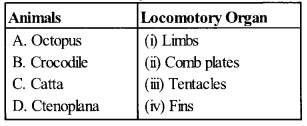
Solution:
A. —> (iii)
B. —> (i)
C. —> (iv)
D. —> (ii)
(a) Octopus The appendages in invertebrates that are used for grasping food and for locomotion are tentacles.
(b) Crocodile for locomotion, and swimming limbs are used.
(c) Catta Fins are means of locomotion and are used to generation optimum thrust thus controlling the subsequent motion.
(d) Ctenoplana Locomotory organs formed by strong cilia with fused bases are comb plates.
SHORT ANSWER QUESTIONS
Question 1.
Differentiate between
(a) Open circulatory system and closed circulatory system.
(b) Oviparous and viviparous characteristic.
(c) Direct development and indirect development.
Solution:
Differentiation between these are as below
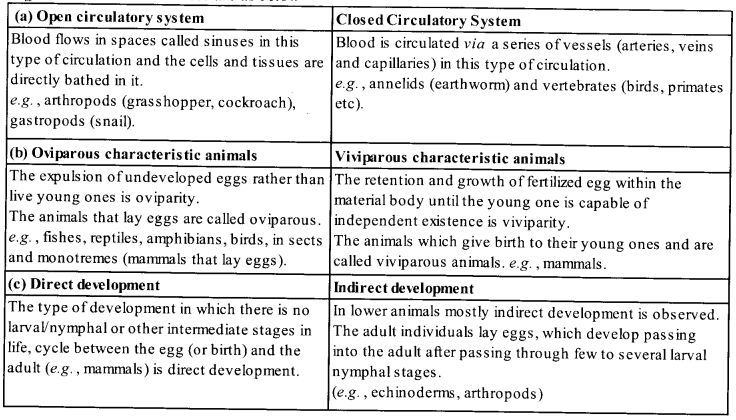
Question 2.
There has been an increase in the number of chambers in heart during evolution of vertebrates. Give the names of the class of vertebrates having two, three or four chambered heart.
Solution:
(a) In organisms like fishes two chambered heart is present. Mixing of oxygenated and deoxygenated blood blood occurs as only one atria and one ventricle is present which are not separated.
(b) After division of auricle into right and left halves three chambered heart develops and in amphibian. In ventiricles mixing of oxygenated and deoxygenated blood occurs.
(c) In reptilies an intermidiary heart is present in which ventricles get partially divided through a septum which is incomplete thus having a false four-chambered heart e.g., Crocodiles.
(d) Both the auricle and ventricle are divided into two halves in four chambered heart and so no mixing of oxygenated and deoxygenated blood occurs, e.g., birds and mammals.
Question 3.
Fill up the blank spaces appropriately

Solution:
Excretion involves the elimination of metabolic waste products from the animal body. In the process of excretion in different animals different organs are involved.
(a) In arthropods excretory products from haemolymph are removed by the malpighian tubules.
(b) The excretory organ occurs as segmentally arranged coiled tubules called nephridia in annelids.
(c) Excretion occurs by paired structures called organ of Bojanus in molluscs also called metanephridia.
(d) Mesonephric kidneys are associated with excretion in amphibians.
The circulation of blood and lymph along with oxygen carbondioxide, hormones, blood cells, etc, within the body system for the nourishment of cells, fighting diseases, and for stabilising body temperature and pH is involved blood circulation.

Respiratory organs are involved in the
exchange of gases from the atmosphere.
Different respiratory organs in various animals.
(a) Lungs and skin in amphibians.
(b) Lung/gills/tracheal system in arthropoda and molluscs.
(c) Skin in annelids.
Question 4.
Match the following

Solution:
A. —> (v)
B. —> (iii)
C. —> (ii)
D.—> (i)
E. —> (vi)
F. —> (iv)
A. Amphibians are found in both aquatic and terrestrial habitat. Their large is completely aquatic while adult lives in terrestrial as well as in aquatic habitat.
B. Mammals produce milk in the mammary glands and feed their young one. The mammary glands are enlarged exocrine modified sweat glands functional in female mammals.
C. Chondrichthyes have (notochord) in the young stage which is gradually replaced by cartilage.
D. Osteichthyes possess air bladder which is a vesicle or sac containing air.
E. Cyclostomes have sucking and circular mouth without jaws which is surrounded by tentacles and the tongue bears teeth, e.g., lamprey and hagfish.
F. Aves comprise of light weighted bones with internal spaces field with air called pneumatic bones and aerodynamic lungs with specialised air sacs. These are the adaptations which enable birds to fly.
Question 5.
Endoparasites are found inside the host body. Mention the special structure, possessed by these and which enables them to survive in those conditions.
Solution:
Endoparasites such as Taenia solium and Fasciola hepatica (liver fluke), etc., are found inside body the host and survive due to the presence of certain characters.
Endoparasites special characters which include:
(i) The is respiration is anaerobic and the gaseous exchange in via general body surface.
(ii) They bear additional organs for the attachment to the host. Taenia solium posses hooks and suckers for the attachment with the host. Fasciola hepatica possesses acetabulum or posterior sucker for the attachment.
(iii) they have well developed reproductive organs. They are generally, harmaphrodite and self fertilisation occurs commonly.
(iv) They have a thick tegument (body covering) which is resistant to the host’s digestive enzymes and antioxins.
(v) Locomotary organs are absent.
(vi) They lack digestive organs because digested and semi digested food of the host is directly absorbed through their body surface.
Question 6.
Mention two similarities between
(a) Aves and mammals
(b) A frog and crocodile
(c) A turtle and Pila
Solution:
(a) Following are the similarities between aves and mammals
(i) Presence of four chambered heart.
(ii) The members of both the groups are homeotherms, i.e., warm blooded. They are able to maintain constant body temperature.
(b) Similarities between frog and crocodile include:
(i) They are cold blooded animals. The members of both the groups are poikilotherms, i.e., they lack the capacity to regulate their body temperature.
(ii) Frogs and crocodiles are oviparous animals.
(c) Similarities between turtle and Pila include
(i) Body is covered with dry and comified skin in both animals. In turtle, the epidermal covering is known as scales whereas in case of Pila, it is known as calcareous shell.
(ii) Both animals are oviparous.
Question 7.
Name
(a) A limbless animal
(b) A cold blooded animal
(c) A warm blooded animal
(d) An animal possessing dry and comified skin
(e) An animal having canal system and spicules
(f) An animal with cnidoblasts
Solution:
(a) Ichthyophis does not possess limbs.
(b) A cold blooded animal scoliodon (dog fish).
(c) warm blooded animal is Columba (pigeon).
(d) Naja naja (snake) possesses dry and cornified skin.
(e) Sycon (sponge) possesses canal system and bear spicules.
(f) Obelia bears cnidoblast.
Question 8.
Excretory organs of different animals are given below. Choose correctly and write in the space provided.
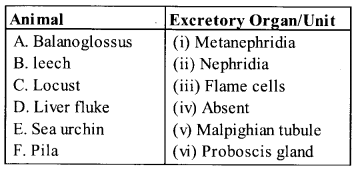
Solution:
Metabolism in body leads to the formation of waste that can affect body’s vital organs so it has to be removed from body. Different classes of organisms possess different types of excretory organs to eliminate the byproduct of metabolism.
A. —> (vi)
B. —> (ii)
C. —> (v)
D. —> (iii)
E. —> (vi)
F. —> (i)
A. Balanogolossus – Proboscis glands. This gland excretes brown granules and is present in front of central sinus.
B. Nephridia in Leech. It helps in osmoregulation and excretion.
C. Malpighian tubules in Locust open into gut and help in excretion.
D. The Flame cells of liver fluke are specialised cells in Platyhelminthes which helps in osmoregulation and excretion. These are also called protonephridia.
E. Sea urchin-absent Specialised excretory organs are absent in sea urchin.
F. It TV/a-Metanephridia is a type of excretory gland or nephridium found in many types of invertebrates such as annelids, arthropods, and molluscs (in molluscus nephridia is also known as Bojanus organ).
LONG ANSWER QUESTIONS
Question 1.
What is the relationship between germinal layers and the formation of body cavity in case of coelomate, acoelomates andpseudocoelomates?
Solution:
Multicellular organisms typically possess a concentric arrangement of tissues in the body. These tissues are derived from the three embrycnio cell, layers called germinal layers.
(i) The outer layer is the ectoderm, the middle layer is the mesoderm and the innermost layer is the endoderm.
(ii) Ectoderm is associated with the formation of CNS, eye lens, ganglia, nerves and glands.
(iii) Mesoderm forms the that in structural components of the body like the skeletal muscles the skeleton, the dermis of the
skin connective tissue, etc.
(iv) Endoderm layer is associated with the formation of the stomach, colon, liver, pancreas urinary bladder and other vital organs is an organism.
(v) Coelom is the body cavity that is lined by mesoderm and the animals possessing coelom are called as ceolomates. e.g., phylum-Annelida, Mollusca, Arthropoda, Echnidermata, Hermichordata and Chordata.
(vi) In some organisms, body cavity is not lined by mesoderm, instead mesoderm is present in the form of scattered pouches in between ectoderm and endoderm, Such body cavity is called pseudocoelom and animals possessing there stusturs are refered to as pseudocoelomates e.g., As car is.
(vii) The animals in which there is complete absence of body cavity are called acoelomates. e.g., Platyhelminthes.
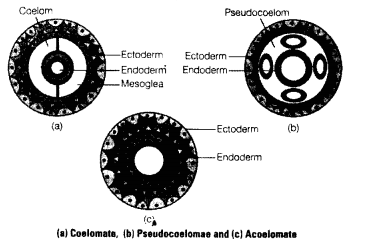
Question 2.
Comment upon the habitats and external features of animals belonging to class- Amphibia and Reptilia.
Solution:
Amphibians
(i) They can dwell in aquatic as well as terrestrial habitats. They are ectothermic or (cold blooded).
(ii) They are tetrapods having (4 limbs) which facilitate movement on land.
(iii) Their limbs have evolved from the pectoral and pelvic fins.
(iv) Skin is thin, covered by mucus and remains mostly moist. It also serves as an accessory source of oxygen.
(v) They breathe through gills and lung gills usually appear in the larval stage, replaced by lungs in the adults stage.
(vi) Their heart is three chambered with two atria and one ventricle.
(vii) Females are oviparous and fertilisation is mostly external.
(viii) Larva is a tadpole, which metamorphose into adult e.g., Rariu frog, Nectureus (mud puppy), Salamandera (salamander).
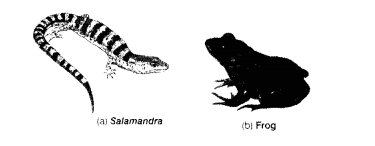
Reptiles
(i) They are mostly terrestrial animals and their body is covered by dry, and comified skin, epidermal scales or scutes.
(ii) In reptiles the mode of locomotion is creeping and crawling.
(iii) Lungs are well developed and present in all stages of life.
(iv) Claws are present in toes.
(v) s Appendages are well adapted for land movement.
(vi) Heart possesses a partially divided ventricle and 2 atria.
(vii) They lay amniotic eggs which are inclubated on land.
(viii) They are poikilothermic or cold blooded animals. Temperature is regulated mechanically and not metabolically by moving in and out; source of heat is usually the sun.
(ix) Fertilisation is internal. They are oviparous and development of young ones is direct e.g., Chelone (turtle), Naja (cobra), Crocodicus (crocodile).
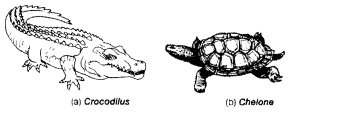
We hope the NCERT Exemplar Solutions for Class 11 Biology at Work Chapter 4 Animal Kingdom, help you. If you have any query regarding NCERT Exemplar Solutions for Class 11 Biology at Work Chapter 4 Animal Kingdom, drop a comment below and we will get back to you at the earliest.